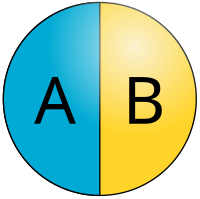
Photo from wikipedia
Micro/nanobubbles play an essential role in ultrasound-based biomedical applications. Here, a green and simple method to fabricate micro/nanobubbles was developed by the temperature-regulated self-assembly of lipids in the presence of… Click to show full abstract
Micro/nanobubbles play an essential role in ultrasound-based biomedical applications. Here, a green and simple method to fabricate micro/nanobubbles was developed by the temperature-regulated self-assembly of lipids in the presence of free bubbles. The self-assembly mechanism of lipids interacting with gas-water interfaces was investigated, and the ultrasound imaging of the obtained lipid-encapsulated bubbles (LBs) was further confirmed. Above the phase transition temperature ( T m ), fluid lipids transform from vesicles to micelles, and further assemble to the free bubbles interface to be a compressed monolayer, resulting in lipid shelled microbubbles. Cooling below T m induces the lipid shell to glassy state and stables the LBs. Moreover, increasing the 1,2-distearoyl-sn-glycero-3-phosphoethanolamine-N-[methoxy(polyethylene glycol)-2000] (DSPE-PEG2K) content in lipids formulation can further manipulate the shell curvature and reduce the LBs size into nanobubbles. LBs with diameters of 1.68 ± 0.11 µm, 704 ± 7 nm and 208 ± 6 nm were successfully prepared. The in vitro and in vivo ultrasound imaging results showed that all of the LBs had excellent echogenicity. The nanosized LBs revealed elongated imaging duration time and greater microvascular details for the liver tissue. Avoiding the organic solvent and complicated multiple preparation process, this method has great potential in construction of various multifunctional micro/nanobubbles with size control for theranostic applications.
Journal Title: Nano Research
Year Published: 2020
Link to full text (if available)
Share on Social Media: Sign Up to like & get
recommendations!